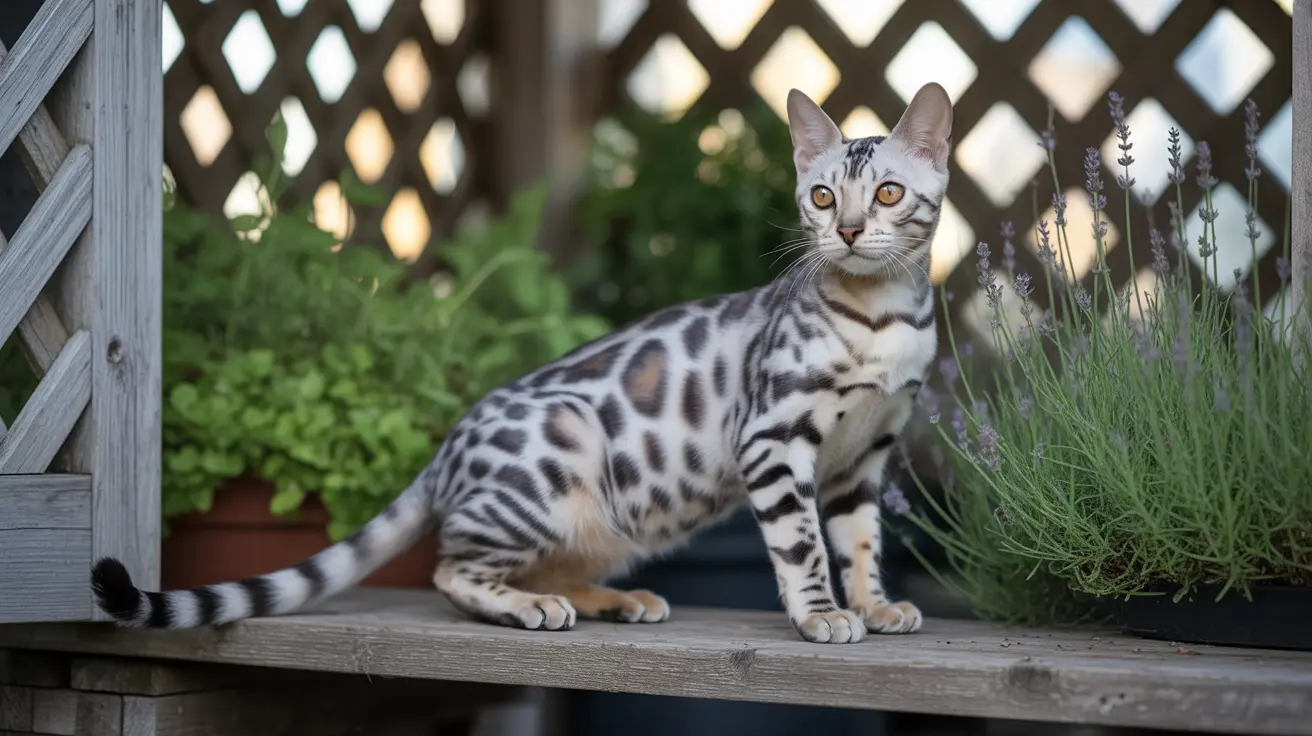Safe Outdoor Cat Free Roaming Guidelines: A Complete Safety Manual for Cat Owners
Allowing your cat to explore the great outdoors can provide immense enrichment and satisfy their natural hunting and territorial instincts. However, free roaming comes with significant risks that require careful planning and preparation. Understanding how to balance your cat's desire for outdoor freedom with essential safety measures is crucial for responsible pet ownership.
This comprehensive guide will walk you through everything you need to know about safe outdoor cat free roaming guidelines, from initial preparation and gradual introduction to ongoing health monitoring and seasonal considerations. Whether you're considering letting your indoor cat experience outdoor life for the first time or looking to improve safety measures for your current outdoor explorer, these evidence-based strategies will help protect your feline companion while preserving their quality of life.
Essential Preparation Before Allowing Outdoor Access
Health and Identification Requirements
Before your cat takes their first steps into the outdoor world, several critical health and safety measures must be in place. Microchipping is absolutely vital for outdoor cats, as it provides permanent identification that cannot be lost like collars. Ensure your microchip information is current and includes multiple contact numbers.
Free-roaming cats require comprehensive vaccination protection beyond standard indoor cat requirements. This includes all core vaccines plus rabies protection, which is essential due to potential exposure to wildlife. Consult with your veterinarian to establish an appropriate vaccination schedule that accounts for your cat's outdoor exposure risks.
Consider pet insurance coverage for outdoor cats, as they face unique medical risks that can result in costly emergency treatments. Outdoor cats are more susceptible to injuries, parasitic infections, and encounters with wildlife that may require immediate veterinary intervention.
Proper Equipment and Access Control
Installing a properly sized cat flap is crucial for allowing your cat to move freely between indoor and outdoor spaces. Ideally, choose a flap that restricts access to only your cat through microchip recognition or magnetic collar systems. This prevents other animals from entering your home while ensuring your cat can seek shelter whenever needed.
Equip your cat with a reflective collar that includes your contact information. The collar should also feature a bell to warn off potential predators and alert traffic to your cat's presence. However, never rely solely on collars for identification, as they can break or be removed.
Creating a Safe Outdoor Environment
Garden and Yard Security
Protecting your cat from busy roads requires securing your garden or seriously reconsidering free-roaming if a safe outdoor area cannot be established. Assess your property's proximity to traffic and consider installing cat-proof fencing or creating enclosed outdoor spaces known as catios.
When designing cat-safe outdoor areas, remove or avoid toxic plants such as lilies, azaleas, and sago palms, which can be deadly to cats. Use feline-safe plants and fertilizers to prevent accidental poisoning. Create multiple levels and hiding spots to allow cats to feel secure and escape potential threats.
Pools and garden ponds present serious drowning hazards for cats. Ensure these water features have safe, accessible exits such as ramps or steps that allow cats to climb out easily. Consider covering water features when not in use or providing alternative safe water sources for drinking.
Predator Protection Strategies
Outdoor cats face threats from various predators including coyotes, raccoons, birds of prey, mountain lions, and bobcats depending on your geographic location. Create secure outdoor spaces with predator-proof features and multiple escape routes. Avoid leaving your cat outdoors unsupervised during dawn and dusk when many predators are most active.
Never leave cat food outside, as this attracts wildlife and creates dangerous encounters. Raccoons, in particular, are competitors that can be aggressive toward cats and carry diseases like rabies, roundworm, and feline distemper. They may view kittens or small cats as prey.
Gradual Introduction to Outdoor Life
Step-by-Step Transition Process
Introduce cats slowly to outdoor environments, especially after moving to a new home or for kittens experiencing their first outdoor exposure. Begin with supervised outdoor sessions in a secure, enclosed area where your cat can retreat to safety if needed.
Start with short 15-30 minute sessions and gradually increase duration as your cat becomes more comfortable and confident. Stay within sight during initial outdoor experiences and use positive reinforcement to create pleasant associations with outdoor time.
Train your cat to respond to recall commands by using high-value treats and consistent verbal cues. Practice recall training in secure areas before allowing unsupervised outdoor access. This skill can be lifesaving in emergency situations.
Establishing Boundaries and Routines
Teach road safety by training cats to stay within yard boundaries and always supervising outdoor time near traffic areas. Create positive associations with your property by placing feeding stations, water sources, and comfortable resting areas within safe zones.
Establish regular feeding schedules to encourage your cat to return home at predictable times. This routine also helps you monitor your cat's health and well-being more effectively.
Health Monitoring and Parasite Prevention
Year-Round Parasite Protection
Effective parasite prevention is absolutely necessary for outdoor cats, using products specifically formulated for felines. Summer represents peak season for mosquitoes, fleas, ticks, and other parasites that can cause skin irritation, allergies, hemobartonellosis, heartworm disease, and intestinal parasites.
Maintain year-round flea and tick prevention using veterinarian-recommended treatments. Regularly check your cat for parasites and consider deworming during summer months if not included in your current preventive treatment plan. Keep your cat's living environment clean and use pet-friendly insect repellents when necessary.
Recognizing Health Warning Signs
Outdoor cats require vigilant health monitoring due to increased exposure to diseases, injuries, and environmental hazards. Watch for signs of heatstroke including excessive panting, drooling, lethargy, disorientation, incoordination, vomiting, diarrhea, collapse, and seizures during warm weather.
Monitor for signs of snake bites, which can be fatal. Warning signs include blue gums, dilated pupils, difficulty breathing, drooping eyelids, localized swelling, paralysis, trembling, and unbalanced gait. Snake bite victims require immediate veterinary care with antivenin treatment.
Regular veterinary check-ups are essential for outdoor cats, as they may hide injuries or illnesses. Schedule more frequent health assessments compared to indoor cats to catch potential problems early.
Seasonal Safety Considerations
Summer Heat Protection
Cats do not sweat effectively and are highly susceptible to overheating during summer months. Provide adequate shelter with cool, shaded areas and increase fresh water supply in multiple outdoor locations. Overweight cats, thick-coated cats, and those with heart or respiratory conditions face higher risks.
Maintain regular grooming to remove excess fur, but avoid shaving cats unless they are severely matted. Their coat actually protects them from sun exposure and helps regulate body temperature naturally.
Winter Weather Adaptation
Cats can adapt to colder temperatures during fall and winter if they remain dry and have access to warm shelter opportunities. Wet fur poses a significantly greater risk than cold temperatures alone. Provide dry, sheltered, warm outdoor spaces if cats cannot access indoor areas freely.
Insulate outdoor shelters with straw rather than hay, as straw provides better insulation and moisture resistance. Ensure shelters are appropriately sized – large enough for comfort but small enough to retain body heat effectively.
Managing Neighborhood Relations
Wildlife and Garden Considerations
Cooperate with neighbors, especially if your cat disturbs local wildlife or damages gardens, to avoid conflicts and maintain positive community relationships. Consider the legal and ethical implications of outdoor cats' impact on bird populations and local ecosystems.
Implement strategies to balance your cat's natural hunting instincts with neighborhood safety concerns. This might include using bells on collars to warn prey animals or limiting outdoor access during peak bird activity periods.
Be proactive in addressing any complaints or concerns from neighbors. Open communication and willingness to implement reasonable solutions can prevent more serious conflicts from developing.
Alternative Solutions
Consider alternatives to complete free roaming if your environment presents significant risks. Secure cat enclosures, leash training, and enhanced indoor enrichment can provide outdoor experiences while maintaining safety.
GPS tracking devices can help monitor your cat's location and movement patterns, providing peace of mind while allowing outdoor freedom. Keep microchip information updated and ensure GPS tracker batteries remain charged.
Frequently Asked Questions
How long should I wait before letting a new cat outside?
Allow at least 2-4 weeks for a new cat to fully settle into your home before introducing outdoor access. This helps establish your home as their territory and reduces the risk of them trying to return to their previous location. Start with supervised outdoor sessions and gradually increase freedom as your cat demonstrates confidence and familiarity with the area.
What vaccinations does my outdoor cat need?
Outdoor cats require all standard core vaccinations plus rabies protection due to potential wildlife exposure. Consult your veterinarian about additional vaccines based on your geographic location and local disease risks. Maintain current vaccination status with regular boosters as recommended by your veterinary professional.
How can I tell if my cat has been bitten by a snake?
Snake bite symptoms include blue gums, dilated pupils, difficulty breathing, drooping eyelids, localized swelling, paralysis, trembling, and an unbalanced gait. These signs require immediate emergency veterinary care with antivenin treatment. Time is critical for snake bite recovery, so seek professional help immediately if you suspect a bite.
Should I bring my outdoor cat inside during extreme weather?
Yes, bring outdoor cats inside during severe weather conditions including extreme heat, thunderstorms, blizzards, and other dangerous weather events. While cats can adapt to seasonal temperature changes, they need protection from extreme conditions that could cause injury or death.
How do I prevent my outdoor cat from hunting birds?
Use bells on reflective collars to warn birds of your cat's approach, limit outdoor access during dawn and dusk when birds are most active, and provide plenty of indoor enrichment to satisfy hunting instincts. Consider puzzle feeders and interactive toys to redirect predatory behavior toward appropriate targets.
What should I do if my outdoor cat goes missing?
Immediately check with local animal shelters, post on social media and community boards, canvas your neighborhood with recent photos, and contact your microchip company to report the cat as missing. Many cats return home within a few days, but quick action increases the chances of a successful reunion.
Is it safe to leave food and water outside for my cat?
Avoid leaving cat food outside as it attracts wildlife and creates dangerous encounters with animals like raccoons and coyotes. Provide fresh water in multiple outdoor locations, but remove uneaten food promptly. Use feeding stations that protect food from insects and wildlife if outdoor feeding is necessary.
Conclusion
Successfully implementing safe outdoor cat free roaming guidelines requires careful preparation, ongoing vigilance, and a commitment to balancing your cat's natural desires with practical safety measures. From proper identification and health protection to environmental modifications and neighborhood cooperation, each element plays a crucial role in keeping your outdoor cat safe and healthy.
Remember that outdoor access involves inherent risks that indoor cats don't face, but with proper preparation and consistent safety practices, many cats can enjoy enriching outdoor experiences while minimizing danger. Regular veterinary care, effective parasite prevention, appropriate equipment, and continuous monitoring will help ensure your feline companion remains safe while exploring the natural world they instinctively crave.






